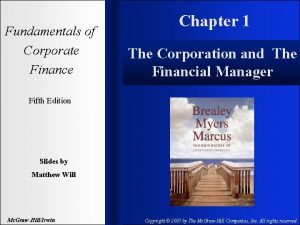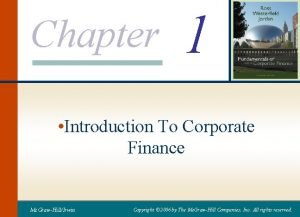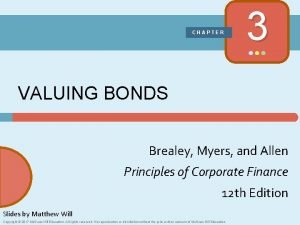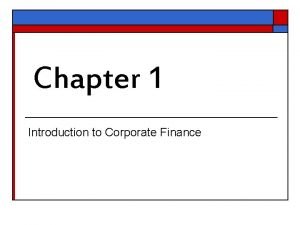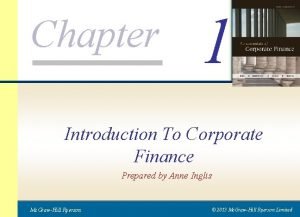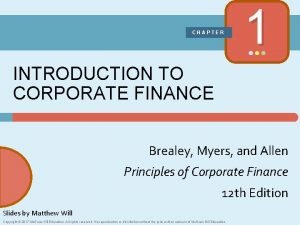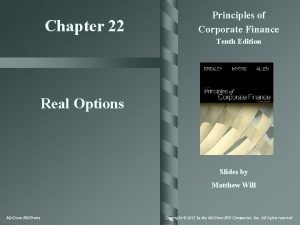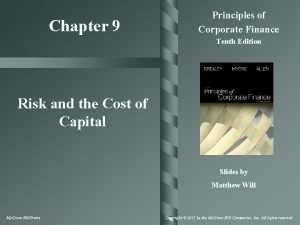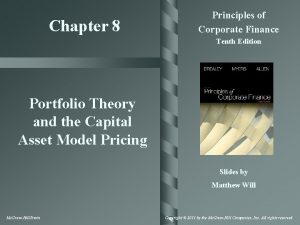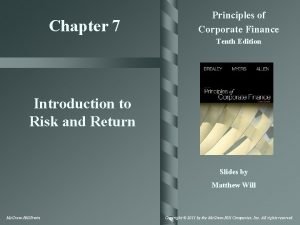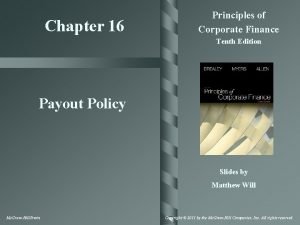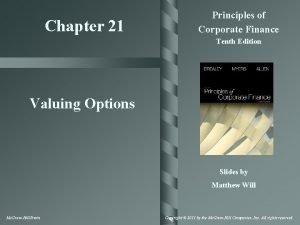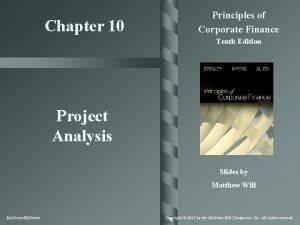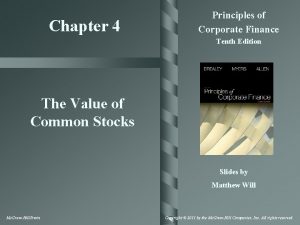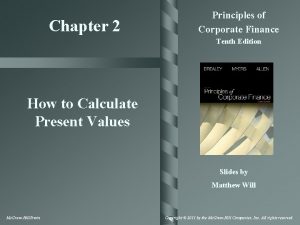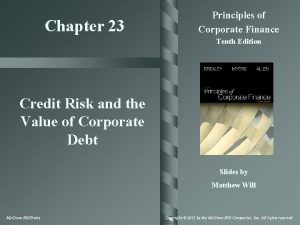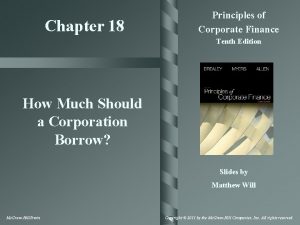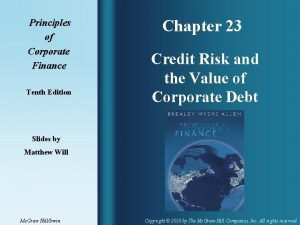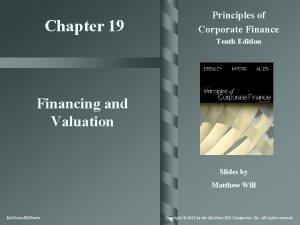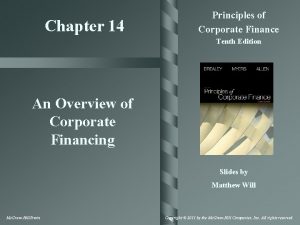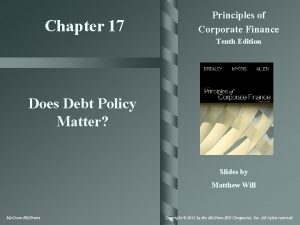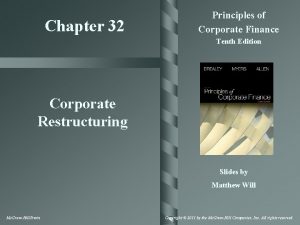Fundamentals of Corporate Finance Tenth Edition Chapter 3




























- Slides: 28

Fundamentals of Corporate Finance Tenth Edition Chapter 3 Accounting and Finance © 2020 Mc. Graw-Hill Education. All rights reserved. Authorized only for instructor use in the classroom. No reproduction or further distribution permitted without the prior written consent of Mc. Graw-Hill Education.

Topics Covered 3. 1 The Balance Sheet. 3. 2 The Income Statement. 3. 3 The Statement of Cash Flows. 3. 4 Accounting Practice and Malpractice. 3. 5 Taxes. 3 -2 © 2020 Mc. Graw-Hill Education

The Balance Sheet 1 Definition • Financial statement that shows the value of the firm’s assets and liabilities at a particular time (from an accounting perspective) 3 -3 © 2020 Mc. Graw-Hill Education

The Balance Sheet 2 The Main Balance Sheet Items Current Assets Current Liabilities • Cash & Securities • Receivables • Inventories • Payables • Short-term Debt + Fixed Assets • Tangible Assets • Intangible Assets = + Long-term Liabilities + Shareholders’ Equity 3 -4 © 2020 Mc. Graw-Hill Education

The Balance Sheet 3 Home Depot’s Balance Sheet (December 31, 2017) $ Millions End of fiscal Assets Current assets Cash and marketable securities Receivables Inventories Other current assets Total current assets Fixed Assets Tangible fixed assets Property, plant, and equipment Less accumulated depreciation Net tangible fixed assets Intangible asset (goodwill) Other assets Total Assets 2017 2016 3, 595 1, 952 12, 748 638 18, 933 2, 538 2, 029 12, 549 608 17, 724 41, 413 19, 339 22, 075 40, 426 18, 512 21, 914 2, 275 1, 246 2, 093 1, 235 44, 529 42, 966 End of fiscal Liabilities and shareholders’ equity Current liabilities Debt due for repayment Accounts payable Other current liabilities Total current liabilities 2017 2016 2, 761 11, 628 1, 805 16, 194 1, 252 11, 212 1, 669 14, 133 Long-term debt Other long-term liabilities 24, 267 2, 614 22, 349 2, 151 Total liabilities 43, 075 38, 633 Shareholders’ equity Common stock and other paid-in capital Retained earnings Treasury stock Total shareholders’ equity 9, 715 39, 935 (48, 196) 1, 454 9, 010 35, 517 (40, 194) 4, 333 Total liabilities and shareholders’ equity 44, 529 42, 966 3 -5 © 2020 Mc. Graw-Hill Education

The Balance Sheet 4 Common-Size Balance Sheet • All items in the balance sheet are expressed as a percentage of total assets. 3 -6 © 2020 Mc. Graw-Hill Education

The Balance Sheet 5 Home Depot Common Size Balance Sheet (December 31, 2017) $ Millions End of fiscal Assets Current assets Cash and marketable securities Receivables Inventories Other current assets Total current assets Fixed Assets Tangible fixed assets Property, plant, and equipment Less accumulated depreciation Net tangible fixed assets Intangible asset (goodwill) Other assets Total Assets © 2020 Mc. Graw-Hill Education 2017 2016 8. 1% 4. 4% 28. 6% 1. 4% 42. 5% 5. 9% 4. 7% 29. 2% 1. 4% 41. 3% 93. 0% 43. 4% 49. 6% 0. 0% 5. 1% 2. 8% 94. 1% 43. 1% 51. 0% 0. 0% 4. 9% 2. 9% 100. 0% End of fiscal Liabilities and shareholders’ equity Current liabilities Debt due for repayment Accounts payable Other current liabilities Total current liabilities 2017 2016 6. 2% 26. 1% 4. 1% 36. 4% 2. 9% 26. 1% 3. 9% 32. 9% Long-term debt Other long-term liabilities 54. 5% 5. 9% 52. 0% 5. 0% Total liabilities 96. 7% 89. 9% Shareholders’ equity Common stock and other paid-in capital Retained earnings Treasury stock Total shareholders’ equity 21. 8% 89. 7% − 108. 2% 3. 3% 21. 0% 82. 7% − 93. 5% 10. 1% Total liabilities and shareholders’ equity 100. 0% 3 -7

Book Values and Market Values 1 Book Values • Value of assets or liabilities according to the balance sheet Market Values • The value of assets or liabilities were they to be resold in a market Generally Accepted Accounting Principles (GAAP) • Procedures for preparing financial statements Equity and asset “market values” are usually higher than their “book values. ” 3 -8 © 2020 Mc. Graw-Hill Education

Book Values and Market Values 2 Example According to GAAP, your firm has equity worth $6 billion, debt worth $4 billion, assets worth $10 billion. The market values your firm’s 100 million shares at $75 per share and the debt at $4 billion. Q: What is the market value of your assets? A: Since (Assets = liabilities + equity), your assets must have a market value of $11. 5 billion 3 -9 © 2020 Mc. Graw-Hill Education

Book Values and Market Values 3 Example (continued) Access the text alternative for these images © 2020 Mc. Graw-Hill Education 3 -10

The Income Statement 1 Definition • Financial statement that shows the revenues, expenses, and net income of a firm over a period of time (from an accounting perspective) 3 -11 © 2020 Mc. Graw-Hill Education

The Income Statement 2 Home Depot’s Income Statement (December 31, 2017) $ Millions Net sales Other Income Cost of goods sold Selling, general & administrative expenses Depreciation Earnings before interest and income taxes (EBIT) Interest expense Taxable income Taxes Net income Allocation of net income Dividends Addition to retained earnings $ Million 100, 904 325 66, 548 17, 864 2, 062 14, 755 1, 057 13, 698 5, 068 8, 630 4, 212 4, 418 % of Sales 100. 0% 0. 3% 66. 0% 17. 7% 2. 0% 14. 6% 1. 0% 13. 6% 5. 0% 8. 6% 4. 2% 4. 4% 3 -12 © 2020 Mc. Graw-Hill Education

The Income Statement 3 Earnings Before Interest and Taxes (EBIT) EBIT = total revenues + other income − costs − depreciation = 100, 904 + 325 − (66, 547 + 17, 864) − 2, 062 = $14, 755 million Home Depot’s Income Statement (December 31, 2017) 3 -13 © 2020 Mc. Graw-Hill Education

Profits versus Cash Flows Differences • “Profits” subtract depreciation (a non-cash expense) • “Profits” ignore cash expenditures on new capital (the expense is capitalized) • “Profits” record income and expenses at the time of sales, not when the cash exchanges actually occur • “Profits” do not consider changes in working capital 3 -14 © 2020 Mc. Graw-Hill Education

The Statement of Cash Flows 1 Definition • Financial statement that shows the firm’s cash receipts and cash payments over a period of time 3 -15 © 2020 Mc. Graw-Hill Education

The Statement of Cash Flows 2 Home Depot Statement of Cash Flows (December 31, 2017) $ Millions Cash provided by operations: Net income 8, 630 Depreciation 2, 062 Changes in working capital items Decrease (increase) in accounts receivable 139 Decrease (increase) in inventories (84) Decrease (Increase) In other current assets (10) Increase (decrease) in accounts payable 352 Increase (decrease) in other current liabilities 669 Total decrease (increase) in working capital 1, 066 Cash provided by operations 11, 758 3 -16 © 2020 Mc. Graw-Hill Education

The Statement of Cash Flows 3 Home Depot Statement of Cash Flows (December 31, 2017) $ Millions (continued) Cash flows from investments: Capital expenditure Sales (acquisitions) of long-term assets Other investing activities Cash provided by (used for) investments (1, 897) 47 (105) (1, 955) Cash provided for (used by) financing activities: Increase (decrease) in short-term debt Increase (decrease) in long-term debt 850 2, 448 Dividends (4, 212) Repurchases of stock (7, 745) Other Cash provided by (used for) financing activities Net increase (decrease) in cash and cash equivalents © 2020 Mc. Graw-Hill Education (211) (8, 870) 933 3 -17

The Statement of Cash Flows 4 Home Depot Statement of Cash Flows (December 31, 2017) $ Millions (continued) Cash provided by operations 11, 758 Cash provided by (used for) investments (1, 955) Cash provided by (used for) financing activities (8, 870) Net increase (decrease) in cash and cash equivalents 933 3 -18 © 2020 Mc. Graw-Hill Education

Free Cash Flow (FCF) • Cash available for distribution to investors after firm pays for new investments or additions to working capital FCF = Net Income + interest + depreciation − additions to net working capital − capital expenditures Home Depot free cash flow = $8, 630 + $1, 057 + $2, 062 − $1, 066 − $1, 955 = $8, 728 3 -19 © 2020 Mc. Graw-Hill Education

Accounting Practice Revenue recognition Cookie-jar reserves Off-balance sheet assets and liabilities 3 -20 © 2020 Mc. Graw-Hill Education

Corporate Tax Rates (2018) Companies pay tax on their income. The U. S. Tax Cuts and Jobs Act, passed in December 2017, reduced the corporate tax rate from 35% to 21%. Thus for every $100 that the company earns, it pays $21 in federal tax. 3 -21 © 2020 Mc. Graw-Hill Education

Taxes 1 Example Taxes and cash flows can be changed by the use of debt. Firm A pays part of its profits as debt interest. Firm B does not. Firm A Firm B $100 Interest 40 0 pretax income 60 100 Tax (21% of pretax income) 12. 6 21 Net Income 47. 4 79 EBIT © 2020 Mc. Graw-Hill Education 3 -22

Taxes 2 FOOD FOR THOUGHT If you were both the debt and equity holders of the firm, which would generate more cash flow to you? Firm A Firm B $100 Interest 40 0 pretax income 60 100 Tax (21% of pretax income) 12. 6 21 Net Income 47. 4 79 EBIT © 2020 Mc. Graw-Hill Education ? 3 -23

Taxes 3 FOOD FOR THOUGHT If you were both the debt and equity holders of the firm, which would generate more cash flow to you? Firm A Firm B Net income 47. 4 79 + Interest 40 Net cash flow 87. 4 ? 0 79 3 -24 © 2020 Mc. Graw-Hill Education

Personal Tax Rates (2018) Taxable Income (dollars) Married Taxpayers Filing Joint Returns 0 to 19, 050 Tax Rate 10. 0% 9, 525 to 38, 700 19, 050 to 77, 400 12. 0% 38, 700 to 82, 500 77, 400 to 165, 000 22. 0% 82, 500 to 157, 500 165, 000 to 315, 000 24. 0% 157, 500 to 200, 000 315, 000 to 400, 000 32. 0% 200, 000 to 500, 000 400, 000 to 600, 000 35. 0% 500, 000 and above 600, 000 and above 37. 0% Single Taxpayers 0 to 9, 525 3 -25 © 2020 Mc. Graw-Hill Education

Taxes 4 Taxes have a major impact on financial decisions. Marginal Tax Rate is the tax that the individual pays on each extra dollar of income. Average Tax Rate is the total tax bill divided by total income. 3 -26 © 2020 Mc. Graw-Hill Education

Taxes 5 Example - Taxes paid by single person making $50, 000 3 -27 © 2020 Mc. Graw-Hill Education

IRS Web Site (www. irs. gov) 3 -28 © 2020 Mc. Graw-Hill Education
 Corporate finance tenth edition
Corporate finance tenth edition Corporate finance tenth edition
Corporate finance tenth edition Corporate finance tenth edition
Corporate finance tenth edition Corporate finance tenth edition
Corporate finance tenth edition Corporate finance tenth edition
Corporate finance tenth edition Fundamentals of corporate finance, third canadian edition
Fundamentals of corporate finance, third canadian edition Fundamentals of corporate finance canadian edition
Fundamentals of corporate finance canadian edition Fundamentals of corporate finance fifth edition
Fundamentals of corporate finance fifth edition Fundamentals of corporate finance 6th edition
Fundamentals of corporate finance 6th edition Digital fundamentals 10th edition floyd
Digital fundamentals 10th edition floyd Fundamentals of corporate finance chapter 6 solutions
Fundamentals of corporate finance chapter 6 solutions Fundamentals of corporate finance chapter 1
Fundamentals of corporate finance chapter 1 Fundamentals of corporate finance, chapter 1
Fundamentals of corporate finance, chapter 1 Corporate finance objectives
Corporate finance objectives Campbell biology tenth edition
Campbell biology tenth edition Campbell biology tenth edition
Campbell biology tenth edition Campbell biology tenth edition
Campbell biology tenth edition Elementary statistics tenth edition
Elementary statistics tenth edition Psychology tenth edition in modules
Psychology tenth edition in modules Introduction to genetic analysis tenth edition
Introduction to genetic analysis tenth edition Campbell biology tenth edition
Campbell biology tenth edition The graph shows data from the light colored soil enclosure
The graph shows data from the light colored soil enclosure Clorosplastos
Clorosplastos Biology tenth edition
Biology tenth edition Chapter 1 introduction to corporate finance
Chapter 1 introduction to corporate finance Principles of corporate finance chapter 3 solutions
Principles of corporate finance chapter 3 solutions Corporate finance chapter 1
Corporate finance chapter 1 Chapter 1 introduction to corporate finance
Chapter 1 introduction to corporate finance Chapter 1 introduction to corporate finance
Chapter 1 introduction to corporate finance












